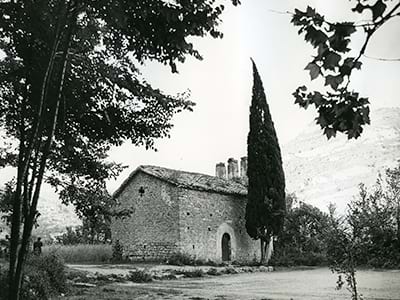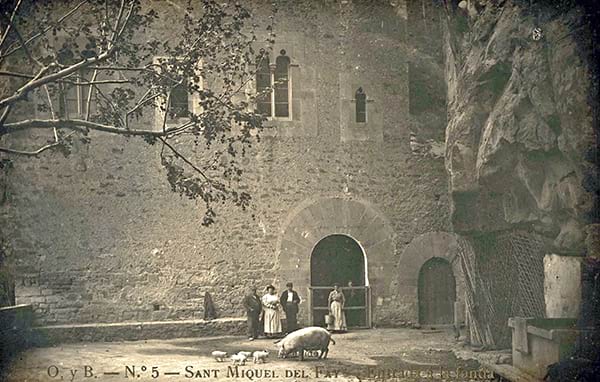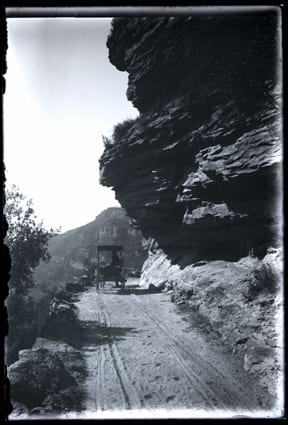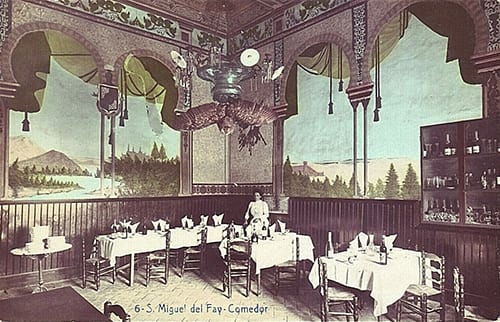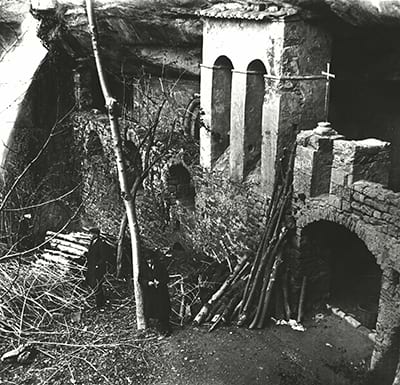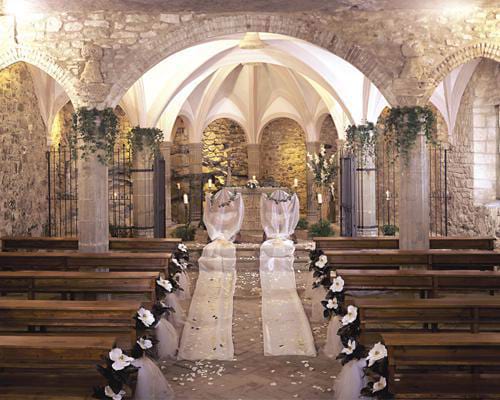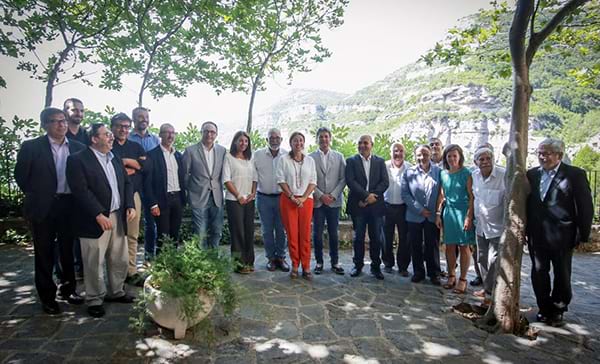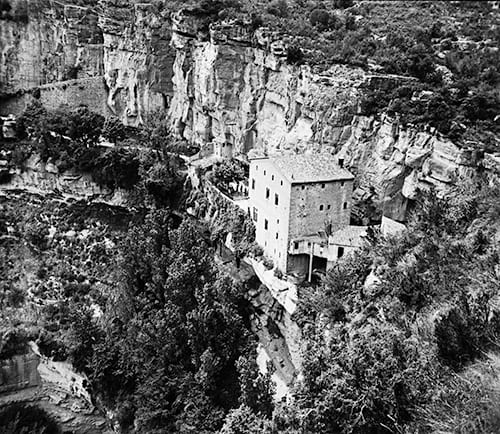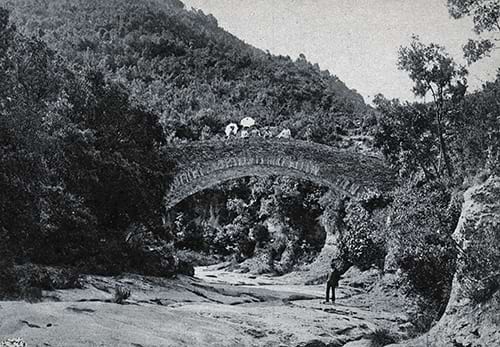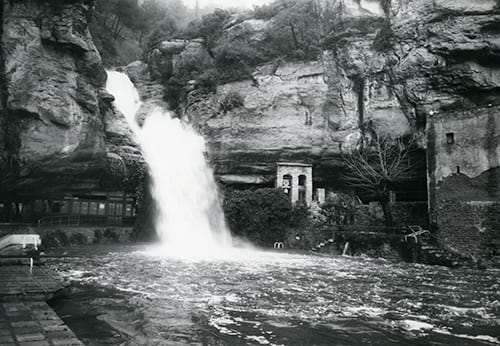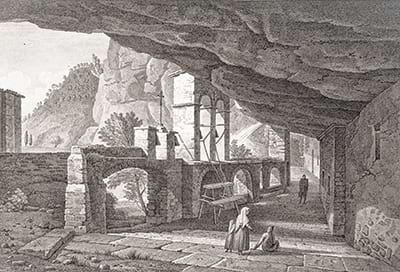

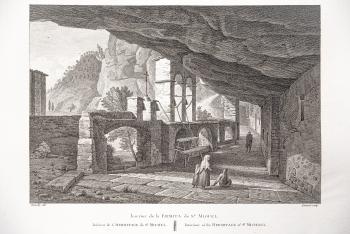
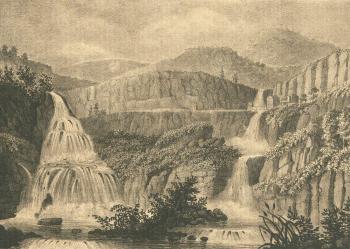


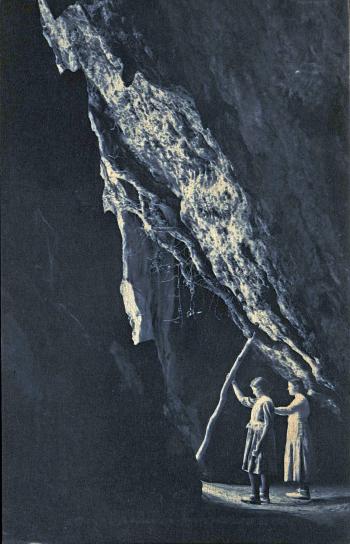
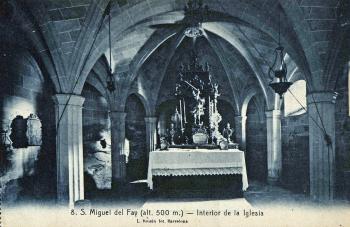
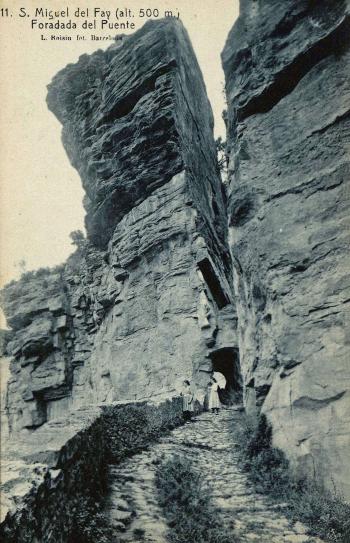
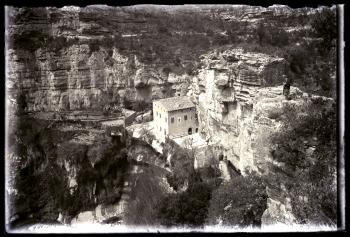

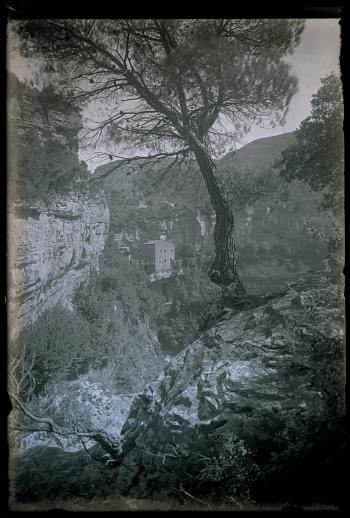
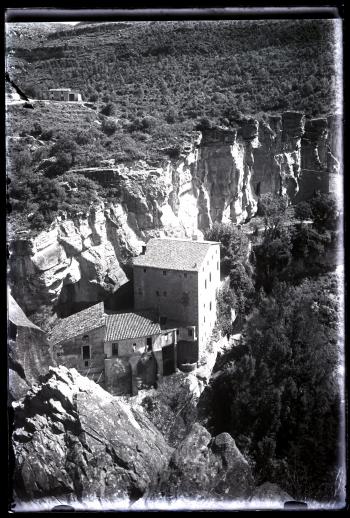
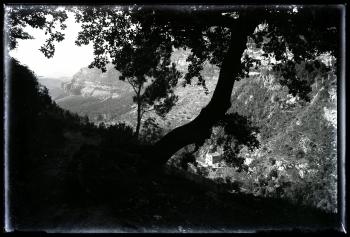
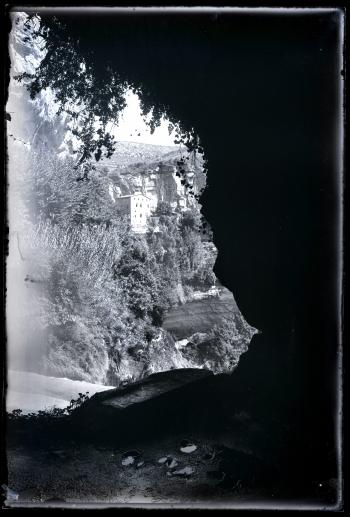
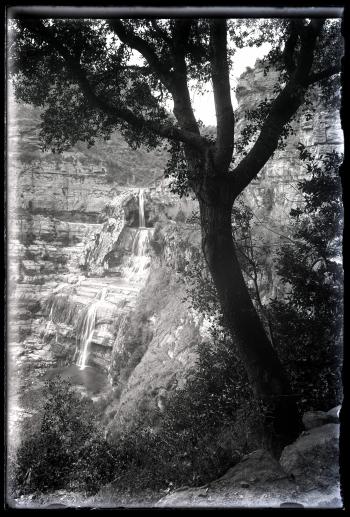
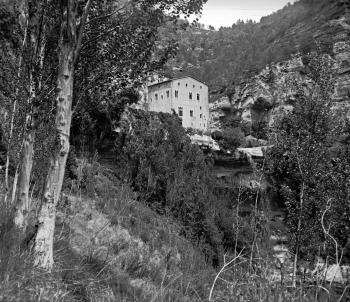
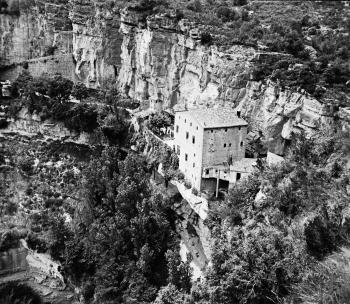
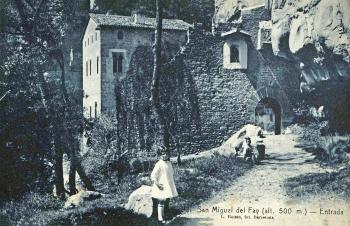
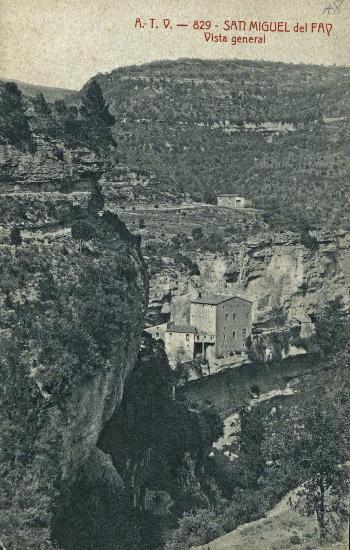

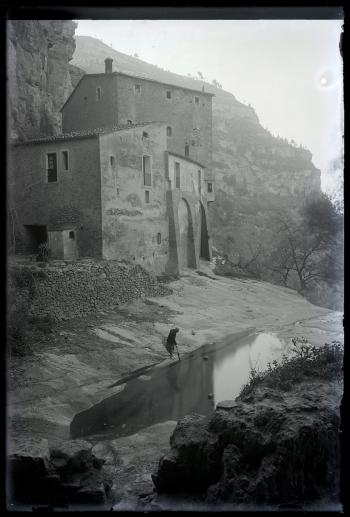
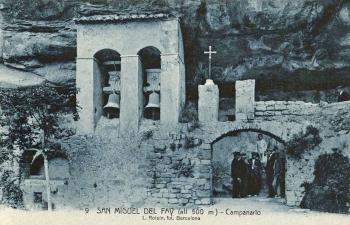
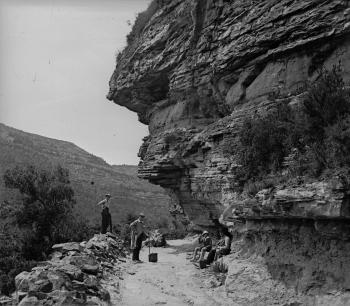
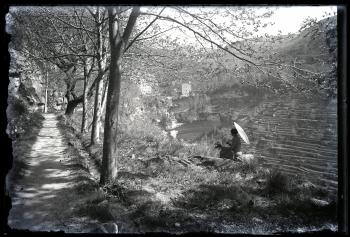
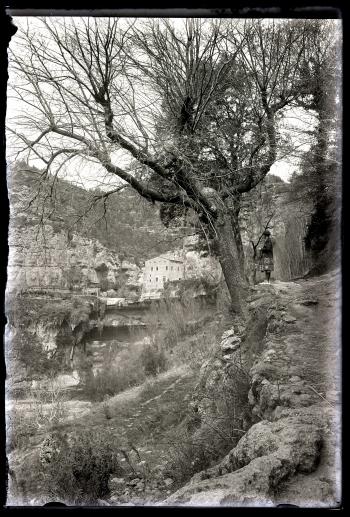
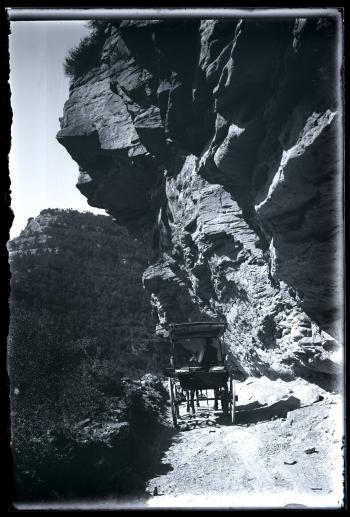
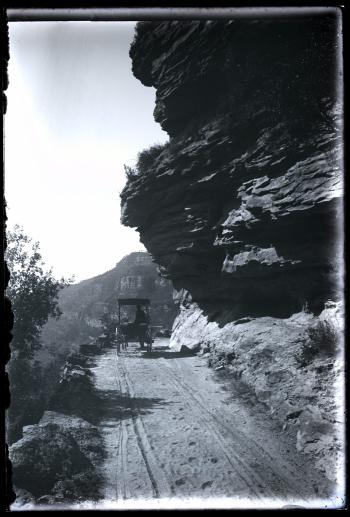
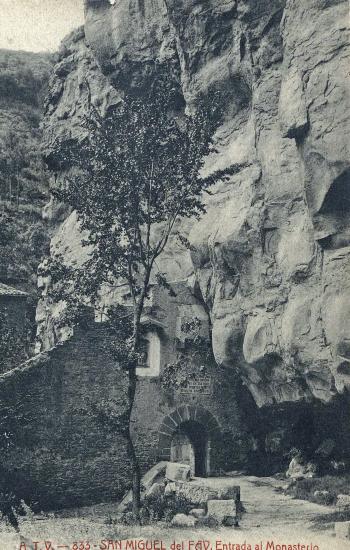
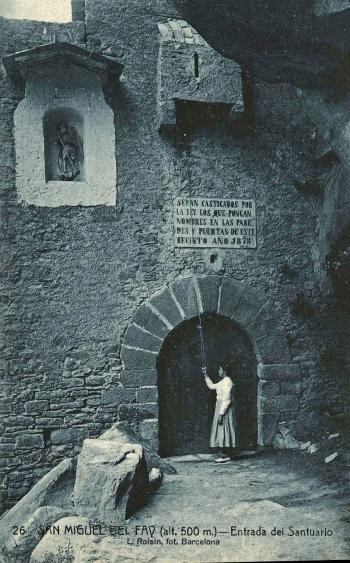
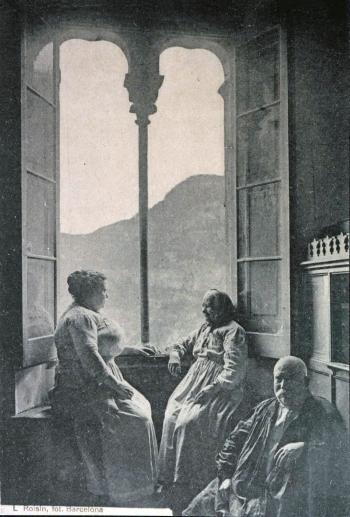


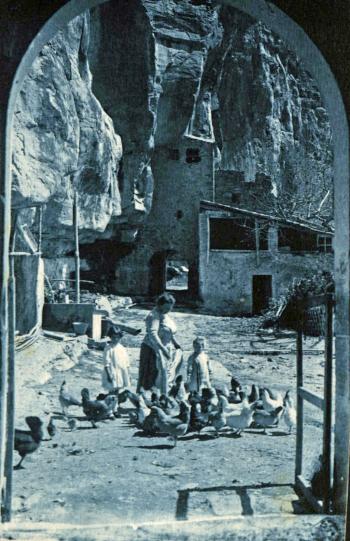
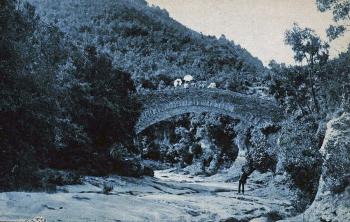
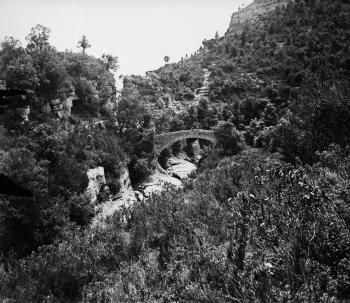
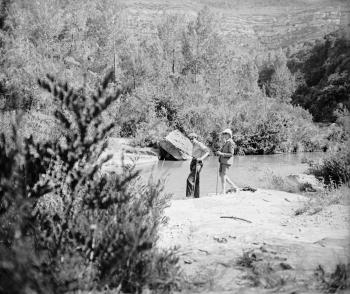
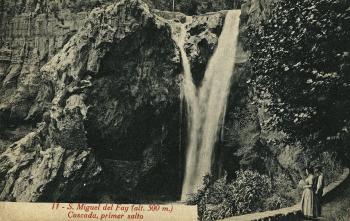
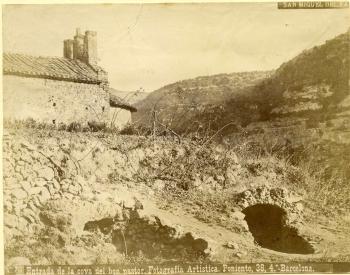
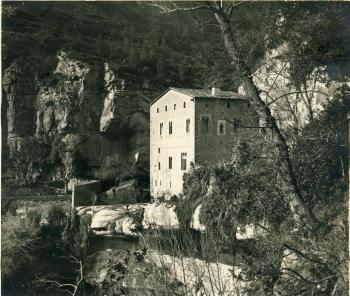
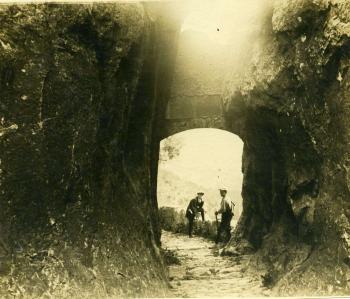
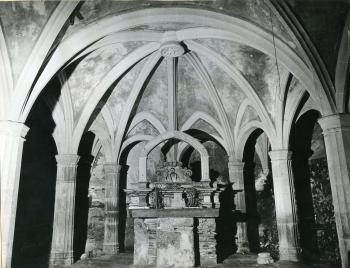
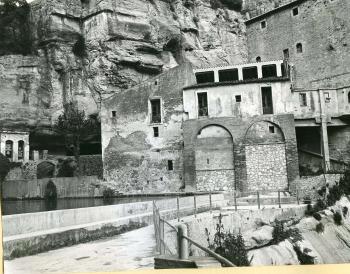
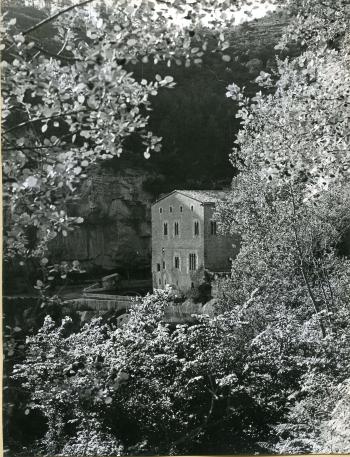
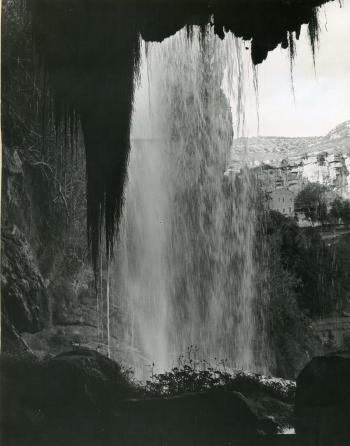
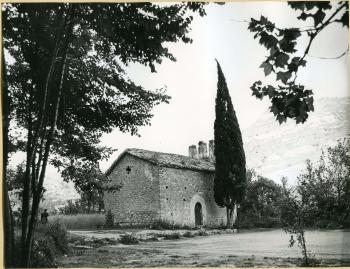
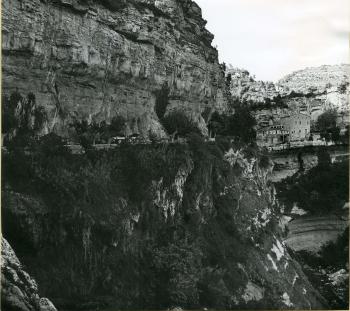
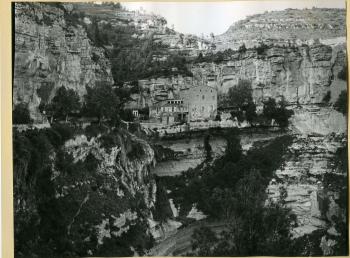
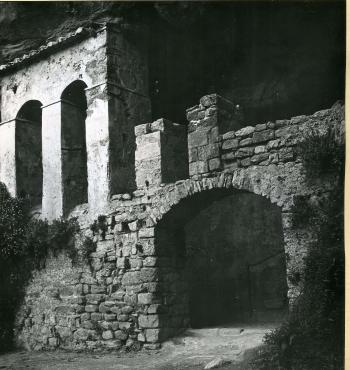
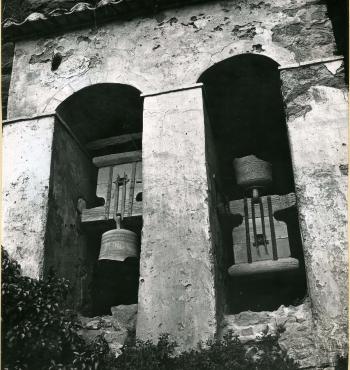
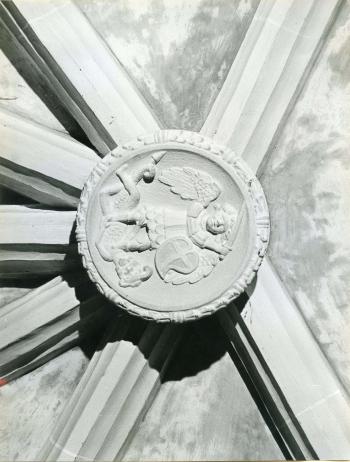
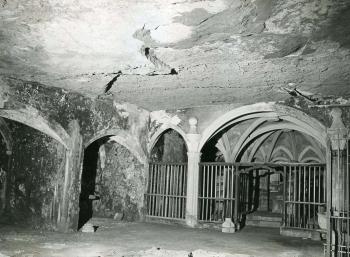
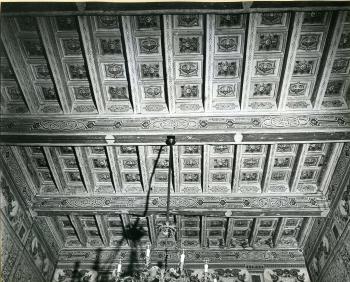
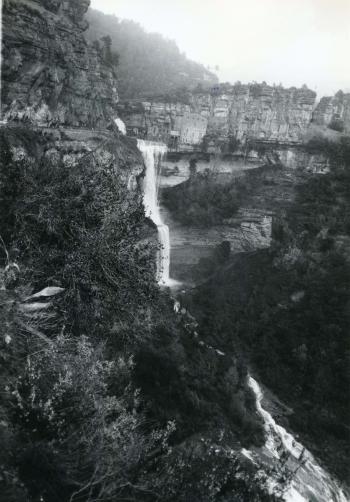
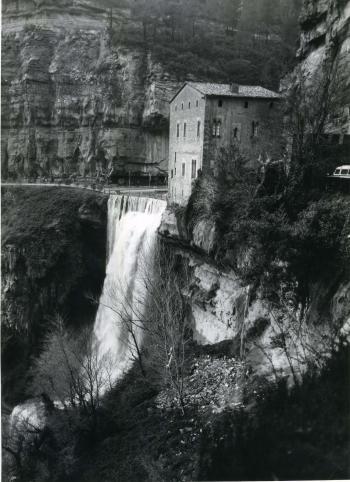
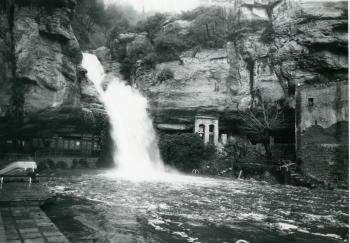
In 2017, the Barcelona Provincial Council acquired Sant Miquel del Fai, a heritage place that has been declared Cultural Asset of National Interest (BCIN) and includes different historic buildings such as Sant Martí del Fai Church, the troglodyte Sant Miquel del Fai Church, Foradada Pass, the Rossinyol Bridge, the fortified gateway and the Priory House, which chronologically span from the 10th century to the present day.
Sant Martí del Fai l’any 1967. Autor: Joan Francès Estorch / Arxiu del Servei de Patrimoni Arquitectònic Local
The first documentation found on the site is related to Sant Martí del Fai Church and dates from the year 878, when it belonged to the monastery of Sant Cugat del Vallès. On the other hand, the first reference to Sant Miquel Church is later, from the year 988, when the counts of Barcelona Ramon Borrell and Ermessenda gave Gombau de Besora and his wife Guilla the allod of El Fai to build a monastery there. The content of this donation seems to indicate that there was already some kind of religious cult in this space, although it has not been possible to determine what type.
In 1042 Gombau ceded the monastery to Saint Victor of Marseilles, being the first Catalan monastery bestowed to the Marseilles abbey. From that moment on, the management of the Fai monastery changed, although until then it was a monastery led by an abbot, from that date it became a priory, with a prior at the head.
Campanar de Sant Miquel del Fai. Autor: Lucien Roisin / Arxiu General de la Diputació de Barcelona
The evolution of the priory under the management of Saint Victor de Marseilles had its ups and downs until the middle of the 14th century, when the office began to be given to commanding priors, some of whom never visited the priory grounds. This change lies in the fact that Pope Urban V, formerly abbot of Saint Victor of Marseilles, placed all the possessions of the Marseilles monastery under the control of the Holy See. This system lasted until 1576, when the Pope of Rome linked the position of prior to that of the major archdeacon of the cathedral of Girona. Some of these archdeacons-priors were very involved in the revitalisation of the Fai, such as Jaume d'Agullana, Isidor d'Horteu or Isidor Bertran.
During the French War (1808-1814) the priory was used as a centre of military operations. Once the hostilities ended, religious normalcy was restored.
Entrada a la Fonda de Sant Miquel del Fai. Autor: O y B / Arxiu General de la Diputació de Barcelona
Possibly, in 1841, during the confiscation of Espartero, the priory was secularised and, between 1850 and 1856, it was sold to the Sisteré family, who turned the place into a tourist centre, hotel and restaurant service. The process was also begun to return worship to the chapels of Sant Miquel and Sant Martí as private oratories.
Carruatge, any 1920. Autor: Narcís Ricart i Baguer/ Arxiu General de la Diputació de Barcelona
In 1875, work began to fix the road that goes from Sant Feliu de Codines to the sanctuary. The Priory House was used as a restaurant and also as a hotel. The press of the time and witnesses give news of one-day visits, and also of long stays. This influx of visitors led to the organisation of a carriage departure service from Canovelles and Sant Feliu de Codines to Sant Miquel del Fai. In this way, the journey from Barcelona could be made in less than two hours.
Postal d’un dels menjadors de la fonda de Sant Miquel del Fai. Autor: Lucien Roisin / Arxiu General de la Diputació de Barcelona
One of the important dining halls was once located in what is known today as the "Chapter Room", which in the early 20th century had walls decorated with oriental paintings, horseshoe arches and columns containing scenes of Adam and Eve in Paradise, a depiction of the city of Barcelona and the legend of Sant Jordi, and the ceiling with a polychrome coffered ceiling.
Sant Miquel del Fai, entre 1920 i 1940. Autor: Arxiu Mas / Arxiu General de la Diputació de Barcelona
Between 1933 and 1936, Sant Miquel continued having a bustling activity as a hotel and tourist attraction, but the outbreak of the Spanish Civil War meant a drastic change. Sant Miquel became a centre of military operations. This had unfortunate consequences for the historic place, such as the burning and desecration of the two churches, which were used as warehouses. The churches were abandoned until 1967, only used as a shelter for hikers or as a corral for the shepherds of Riells.
L’església de Sant Miquel, decorada per un casament. Autor: ibodas.com
The damage and the harshness of the post-war years made excursions to Sant Miquel del Fai vanish. These did not recover until the late 1950s. The many successive owners (José Orfila Fortuny, Gabriel Camps and Santiago Rubies, PROMEFIC. S.L., and Espai Natural Sant Miquel del Fai S.A.) continued with the tourism and catering business, with an increasingly diversified use of the facilities, with services such as banquets and weddings. This meant that several reforms were made to adapt it to the needs of the activity, especially in the years 1967-1968 and 1990-2017.
Presentació de la compra de Sant Miquel del Fai, el 2017. Autor: Diputació de Barcelona
In 2017, following the requests of several neighbouring municipalities of Vallès Oriental and Moianès, the Provincial Council of Barcelona purchased Sant Miquel del Fai with the intention of recovering this place of great natural and cultural interest for greater use and free access to the general public.
Constructive stages
Sant Miquel del Fai. Autor: desconegut / Arxiu General de la Diputació de Barcelona
Regarding the constructive evolution of the historic place, three construction stages can be broadly distinguished. The first, between the 9th and 16th centuries, when the place would feature the churches of Sant Martí and Sant Miquel del Fai and a priory house, probably located in the area that is now known as the pools, although it has not been ruled out that it was situated in the same location as the current one.
Pont del Rossinyol. Autor: Lucien Roisin / Arxiu General de la Diputació de Barcelona
A second phase, comprised between the end of the 16th century and the 20th century, which would be marked by its ties with the high archdeaconry of the cathedral of Girona, especially during the period of the leadership of Archdeacon Agullana.
This stage meant a revitalisation of the monastic ensemble and the impetus for an important renovation in which Rossinyol Bridge and the Foradada Pass were built to open a new entrance from the east to the monastic enclosure, with the Fortified gateway and presumably the current Gothic-style Priory House.
Salt del Rossinyol i piscina, 1980. Autor: Joan Francès Estorch / Arxiu del Servei de Patrimoni Arquitectònic Local
Finally, during the 20th century, the grounds were arranged with the construction of baths (pools), and around the turn of the century, renovation was carried out on the Priory House, where it is worth noting the chipping on the walls that led to the loss of the wall paintings that decorated different rooms of the building. A souvenir shop was also built, located behind the fortified gate, an audiovisual room and a small museum were fitted out with glass enclosures under the cliff overhang, and the grotto was illuminated. In the 1990s, the last owners carried out major works to adapt the priory as a centre for banquets and weddings.
Claustre de l'església de Sant Miquel del Fai. Voyage pittoresque et historique de l'Espagne, d’Alexandre Laborde (1806). Arxiu del Servei de Patrimoni Arquitectònic Local
Sant Miquel del Fai has been visited, described and drawn by travellers of the 18th century such as Francisco de Zamora and Alexandre Louis Josep, Marquis of Laborde. The same can be said of the poets of the romantic era, such as Víctor Balaguer and Francesc Camprodon, who dedicated some of their works to it. In full romanticism, the beauty of the Fai also drew writers such as George Sand, the male pseudonym of Amandine Aurore Lucile Dupin, Lord Byron and Theòphile Gautier, who were awed by the caves and the site. The writer Josep Pla, who has a statue on the path between the two churches, also visited the site and wrote about the excursion, without being able to admire the waterfalls due to the drought at the time.
Local Architectural Heritage Service of the Provincial Council of Barcelona
Sant Miquel del Fai
Espai Natural dels Cingles de Bertí
BV-1485, km 7
08416 Bigues i Riells del Fai
Tel. 666 541 593 - dies laborables
Tel 666 541 721 - Dissabtes, diumenges i festius
santmiqueldelfai@diba.cat


